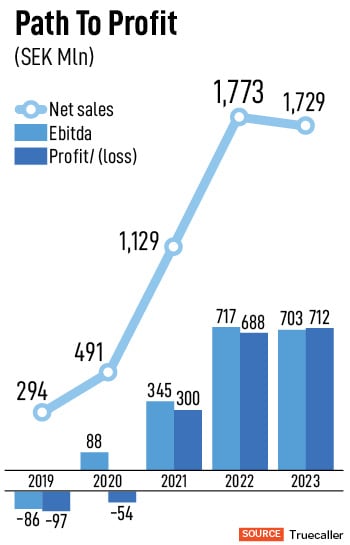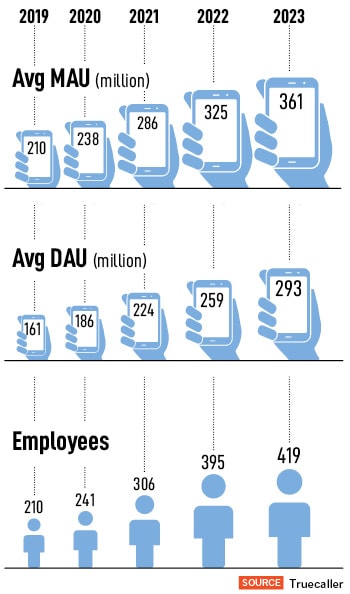What Truecaller's co-founders stepping back means for the company
Alan Mamedi and Nami Zarringhalam co-founded Truecaller and built it into a 400 million-user app. Now, they have stepped back, as the company enters its next phase of growth


Fifteen years ago, inside a small kitchen in Stockholm, amidst the unfolding chaos of the global financial crisis, two college friends dabbled with the idea of creating a mobile phone application to tackle the problem of pesky calls. In the first week of its launch, the app was downloaded by 10,000 users. “That’s when we decided to just go all in on it," the duo recalls. “We did the things we were passionate about. but we didn’t foresee it becoming this big."
This is how Alan Mamedi and Nami Zarringhalam, of Kurdish and Iranian origin respectively, co-founded global caller ID and call blocking app Truecaller in 2009. A few years later, the Stockholm-headquartered company started its India operations after Peak XV (formerly Sequoia India and Southeast Asia) invested around $20 million in 2013.
Shailesh Lakhani, managing director, Peak XV, says the Mamedi and Zarringhalam were quite unlike most other founders he had interacted with over the years. “They had a very small team, they were very frugal, and I think our investment was five to six times more than what they had ever raised before," he tells Forbes India. “What’s amazing about their journey is that the user growth has never slowed down."
 Truecaller now has over 400 million users worldwide and listed on Nasdaq Stockholm in October 2021. Lakhani says he is excited about the company’s potential to tap into commercial services among other segments as scams continue to rise. “In the short-term, I’m most excited about Apple allowing Truecaller to work on iOS," he adds.
Truecaller now has over 400 million users worldwide and listed on Nasdaq Stockholm in October 2021. Lakhani says he is excited about the company’s potential to tap into commercial services among other segments as scams continue to rise. “In the short-term, I’m most excited about Apple allowing Truecaller to work on iOS," he adds.
But Mamedi and Zarringhalam’s entrepreneurial journey is anything but a straight line. About two years after raising funds from Peak XV, the founders raised a bigger and undisclosed round of capital. Aflush with money, the company expanded haphazardly and went on a hiring spree. “When you hire that quickly, you frequently get it wrong," Lakhani cautions. “They hired a very large team but not everybody was a great fit and money was running out and they needed to right-size costs as well as start making money."
This phase taught Truecaller’s chief executive officer Mamedi and chief strategy officer Zarringhalam tough lessons and pushed them to reduce their dependence on investors and focus on profitability. “From that point on, Alan and I decided to trust our gut feeling, and luckily, it"s been eight or nine years and we haven"t gotten into that situation again," Zarringhalam says in an interview on Forbes India Pathbreakers. The company turned a corner and posted its first-ever profit in 2019 even as it continued to expand its operations.
 “As an immigrant, back in the day, you were also always an underdog because you looked different from the other and, in some way, it creates this mentality that you want to prove that you"re better and you feel that you need to work much harder to reach there," Mamedi reminisces. “It creates a very strong resilience to actually go the extra mile, creating a lot of hunger and drive to reach the top. At the same time, it has also made me very humble because it makes me appreciate things and not take anything for granted."
“As an immigrant, back in the day, you were also always an underdog because you looked different from the other and, in some way, it creates this mentality that you want to prove that you"re better and you feel that you need to work much harder to reach there," Mamedi reminisces. “It creates a very strong resilience to actually go the extra mile, creating a lot of hunger and drive to reach the top. At the same time, it has also made me very humble because it makes me appreciate things and not take anything for granted."
In an unexpected move, on November 6, after securing the approval of the board, Mamedi and Zarringhalam announced their decision to step back from their operational duties at Truecaller from June 30, 2025. The co-founders said they would continue to focus on Truecaller’s long-term strategy as board members and advisors, but allow the leadership team to take full ownership and drive Truecaller’s growth.
“The company is on a really exciting path, with user growth accelerating globally, revenue streams growing at a strong pace, iOS platforms opening up for exciting opportunities, and a positive trend emerging in advertising," Mamedi wrote on a microblogging platform. “With an exciting product roadmap ahead, we are confident that Truecaller’s future is incredibly bright."
 Mamedi and Zarringhalam, who own a 7.76 percent stake each in Truecaller, named Rishit Jhunjhunwala as the new group CEO. “Over the past two years, I’ve had the privilege of personally mentoring Rishit to take on a larger role within the company, and Nami and I are confident that he is ready to lead the company on a global scale," Mamedi said.
Mamedi and Zarringhalam, who own a 7.76 percent stake each in Truecaller, named Rishit Jhunjhunwala as the new group CEO. “Over the past two years, I’ve had the privilege of personally mentoring Rishit to take on a larger role within the company, and Nami and I are confident that he is ready to lead the company on a global scale," Mamedi said.
Jhunjhunwala will step into the new role on January 9, 2025. He joined Truecaller as the head of product in 2015 and spent the first seven years in Stockholm. He moved to India in October 2021 and has been steering Truecaller’s global ads and enterprise business as India CEO.
“His deep product knowledge and leadership experience have been critical to our success, and we have always regarded him as a co-founder of Truecaller," Mamedi adds. “As a product-first company, it is crucial to have a CEO who understands our products at their core, and Rishit embodies the values that have shaped our company into what it is today."
Truecaller earns roughly 80 percent of its total revenue from the advertising business. India contributes nearly 74 percent to the Swedish company’s global revenue, and also accounts for its largest employee and user base.
“Our ads play has been the biggest revenue earner for us," Jhunjhunwala tells Forbes India. “Having a powerful free app is an important aspect of our business and our premium tier is for advanced users." He believes Truecaller has a strong advantage over competitors in this fast-changing and dynamic industry. “Our biggest moat is our learnings of over 15 years," he adds. “We’ve only got started and we’ve only scratched the surface so far."

As battle-hardened pioneers in this space, Mamedi and Zarringhalam have seen the regulatory landscape change as data privacy concerns loom large in most countries. Their entrepreneurial journey has often been marked with scepticism about their business model. In 2022, Viceroy Research, a US based short-seller, released a scathing report called ‘Truecaller’s True Colours’, accusing Truecaller of wrongdoings ranging from tax fraud to data theft.
On its part, Truecaller has refuted all these allegations: “Their only job is to make money by making up lies. It"s been over two years since the short-seller came with its report and so far not a single thing that came out of it has turned out to be true."
“It"s hard to change a misconception it always is. It"s quite well known that most large and successful tech companies collect a lot of information. So, people assume that just because Truecaller is a very successful and large company, we also do that, but we don"t," Mamedi clarifies. “We all know what companies like Google and Facebook do and we"ve always had this stance that we want to be an independent company that does things our way, which is protecting our consumers."
On November 7, a day after the founders named Jhunjhunwala as group CEO, fresh trouble erupted, with India’s tax authorities raiding Truecaller’s India offices at Gurugram, Mumbai and other locations over allegations of violation of transfer pricing norms. “Truecaller’s transfer pricing policy for its intra-group transactions is consistent with the internationally accepted arm’s length standard," the company said in a subsequent press note. “The purpose is to ensure that Truecaller pays tax in a way that is correct from the perspective of both the Swedish and the Indian tax authorities." At the time of writing this piece, there were no further updates on this development.
First Published: Nov 26, 2024, 14:14
Subscribe Now